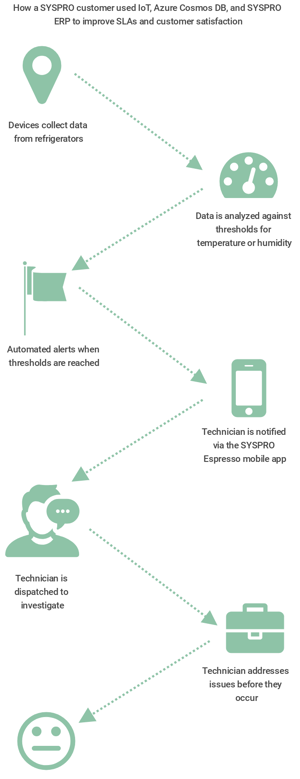Whether we like it or not, technology is ubiquitous, and it's only a matter of time before almost everything in our lives is a "smart" device, connecting us to each other, the internet and the world around us.
This new reality is made possible by innovative technologies like the internet of things (IoT), a global system of interrelated devices that can exchange information without human intervention.
Having everything connected may seem scary — especially when everything happens behind the scenes and we’re not even aware which devices are capturing what information or how is it managed. When used appropriately, IoT, combined with software and sensors, can be extremely beneficial — not only for businesses, but for their customers as well as consumers in general.
To better understand how IoT can impact all of us, let’s take a look at how it works, how it is utilized, and how everyone can benefit from using it.
How IoT works
As the name implies, IoT is about “things” connected to the internet. The internet connected people, and then the cloud allowed computers all over the world to exchange information; now any device with internet capability can also be added to the world wide web.
Until recently, only sophisticated sensors were able to capture and transmit information from separate locations. These days, most new devices can be connected to the internet, including your refrigerator, washer and dryer, oven, and home appliances.
All these devices are connected to the internet for two main reasons:
- So you can control them remotely. For instance, if you forgot to turn off the oven when you left home, you can do so remotely. You can even cook and bake remotely. (Source)
- Device manufacturers collect data on usage and performance for maintenance purposes and to improve their products.
Beyond B2C, IoT can also be used in the B2B space. It is estimated that the number of IoT units used by companies will almost double by 2020, from 4.16 billion to 7.55 billion.

Find more statistics at Statista
How IoT is used by companies
Most articles about IoT implementations describe huge projects initiated by multinational companies like GE or Siemens for enterprise customers, but IoT can significantly benefit smaller companies as well. Moreover, now that technology and devices like sensors are more affordable than ever, it only takes a bit of creativity for SMBs to implement IoT successfully.
Here are a few examples of IoT software reviews that describe the business problems SMBs solved using this type of technology:
“I’ve used this as a tool to help me work remotely without losing access to a broad range of resources and devises or documents.”
— AWS IoT review from a user in commercial real estate
“I have realized benefits like saving on spare parts by accurately buying which parts i am most likely to need.”
— Autodesk Fusion Connect review from Nitish J., a user in industrial automation
IoT and ERP
Another great example is the story of a company that delivers equipment maintenance services for grocery retailers. The primary goal of the company is to keep refrigerators up and running, preventing retailers from being disrupted by unplanned downtime. Meanwhile, the company’s primary challenge when working toward this goal was the inability to be proactive or anticipate issues. In an ideal world, the company would have been able to somehow track characteristics such as temperature and humidity 24/7, which was impossible to accomplish with traditional technology.

With the help of SYSPRO, an ERP system and services provider, the company found a way to monitor refrigerators, identify potential problems, and proactively dispatch field technicians to investigate before issues occurred.
Here’s how they did it:
- The company installed sensors in all refrigerators to track temperature and humidity
- The data was transferred using the SYSPRO infrastructure and stored in the cloud
- The company defined thresholds and analyzed the information in SYSPRO
- The SYSPRO Hub detected when an item needed attention
- Using the SYSPRO Workflow Connector, the company created alerts and automated workflows
- The workflows triggered notifications that technicians received on their SYSPRO Espresso mobile app
- Technicians investigated and addressed the issues when necessary
As a result, the company saw a significant increase in SLAs that reached a level of nearly 90%. Downtime was also dramatically reduced, the retailer almost eliminated loss of goods due to malfunctioning refrigerators, and its customers had access to fresh produce at all times. All this without a significant investment in technology.
How everyone benefits
As mentioned above, the interconnection between billions of devices may seem like a scary concept. Still, it can be extremely beneficial for everyone.
- The service provider is more efficient and cuts costs by dispatching technicians only when needed. This does not mean that the company will reduce its number of technicians; instead, it can retain more customers and achieve high SLAs with the same personnel.
- Technicians also benefit because they spend less time traveling back and forth, and more time focusing on what they do best: fixing things.
- The company provides a better customer experience and avoids disruption. This can decrease its operational costs, attract more customers, and increase profits.
- Customers are better served, which can increase loyalty and satisfaction. Happy customers may also share their satisfaction with family and friends.
Conclusion
To stay competitive in the digital economy, all companies must use technology innovations to enhance their business operations. Therefore, adopting a robust digital platform to support the business and its adoption of technology is more critical than ever.
All businesses need core software functions such as financial management, customer management, customer service, etc., but the adoption of these products alone is no longer sufficient to stay competitive. Inside the digital platform, inside core business functions, a business needs to be able to incorporate value-adding technology such as AI/ML, blockchain, and IoT. Embedding technology inside the digital platform allows all core functions to leverage these capabilities both when they are needed and where they have the highest impact.
IoT can add value across many business functions, from asset management and supply chain, to manufacturing and field service. In addition, using IoT can reduce costs and increase productivity by preventing downtime and notifying maintenance personnel when conditions are out of tolerance.
In SYSPRO’s latest release, SYSPRO 8, users of its ERP software can take advantage of Microsoft’s robust Azure IoT platform and enable a broad set of solutions. Merging the capabilities of a specialized digital platform into the framework of a business system’s digital platform is still a reasonably new concept, but will likely become much more prevalent over time.
Leveraging the considerable capabilities of a set of services (like Azure) by an ERP vendor (like SYSPRO) is a way to quickly accelerate the ability of its customers to adopt leading-edge technology and deploy that technology within its core business systems. This could be a significant competitive boost for a business and simplify several technology decisions.
Interested in learning more? Check out how how artificial intelligence is powering the IoT.
 by Sagar Joshi
by Sagar Joshi
 by Holly Landis
by Holly Landis
 by Sagar Joshi
by Sagar Joshi